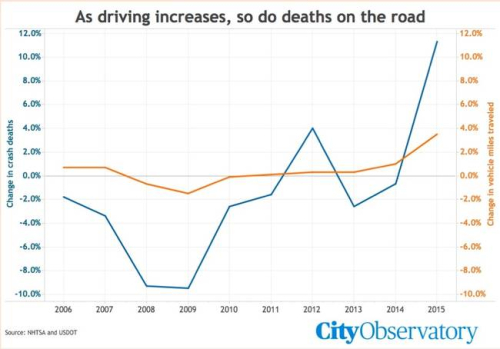Traffic Fatalities Increase… Drive to Stay Alive
The National Safety Council recently announced that traffic fatalities for 2015 rose significantly from the previous year. The estimated 38,300 people killed on US roads represent the largest year for year increase in 50 years, and makes 2015 the deadliest year since 2008.
Lower gasoline prices and job growth have had an impact on the number of miles driven in the last few years, but the rise in fatalities seems to be outpacing the rise in miles driven. The following excerpt is taken directly from the National Safety Council:
"These numbers are serving notice: Americans take their safety on the roadways for granted," said Deborah A.P. Hersman, NSC president and CEO. "Driving a car is one of the riskiest activities any of us undertake in spite of decades of vehicle design improvements and traffic safety advancements. Engage your defensive driving skills and stay alert so we can reverse this trend in 2016."
In a continuation of the bad news, preliminary numbers indicate this trend is continuing in 2016. In the first six months of 2016 traffic fatalities increased 9% over 2015. Add to this the 2.2 million people injured in crashes in those six months. Every driver should be concerned; 100 people dying on the roads every day is simply unacceptable.

So what do we do about this? The increase in driving plays a part in the increase in fatal crashes, but so does complacency, distraction, speeding, and fatigue. These are all factors that are within our control as average drivers. Getting behind the wheel includes the inherent responsibility for our own safety, but also for the safety of everyone else we encounter on the roadway.
Technology improvements have made vehicles safer than they have ever been. Survivability rates in many models are unprecedented. However, the driver is still the weak link in the chain and all the technology in the world currently does not make up for poor decision making. The future may include driverless cars, but in 2016 we, the vehicle operators, are still responsible for nearly every crash that occurs.
The solution to the problem is actually pretty straightforward:
- Avoid driving when fatigued.
- Plan your trip and leave with plenty of time to account for weather or traffic delays.
- Follow the rules of the road… always.
- Never mix driving with alcohol or drugs that may impair your ability to drive.
- Never, never, never text while driving.
- Let phone calls go to voice mail, and pull over to a safe area before making a cell phone call in the vehicle. No text or phone call is worth the increased risk of a crash.
For additional information regarding safe driving practices check out the resources available from the National Highway Traffic Safety Administration, the National Safety Council, and the National Transportation Safety Board. Let’s all make a concerted effort to reverse this recent trend. The life you save may be your own!

